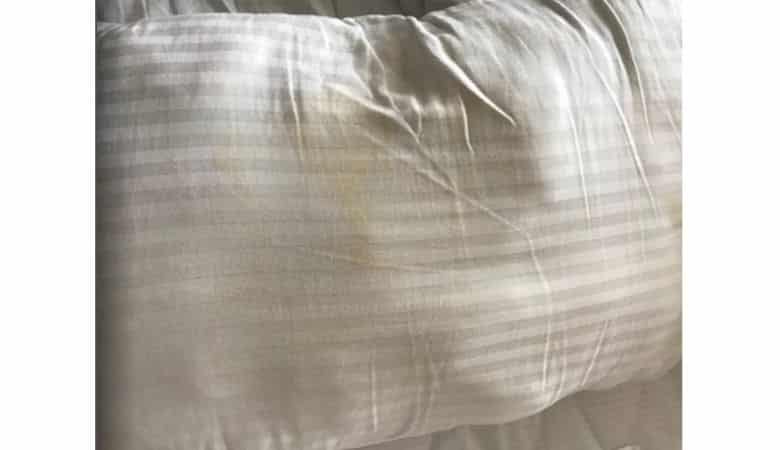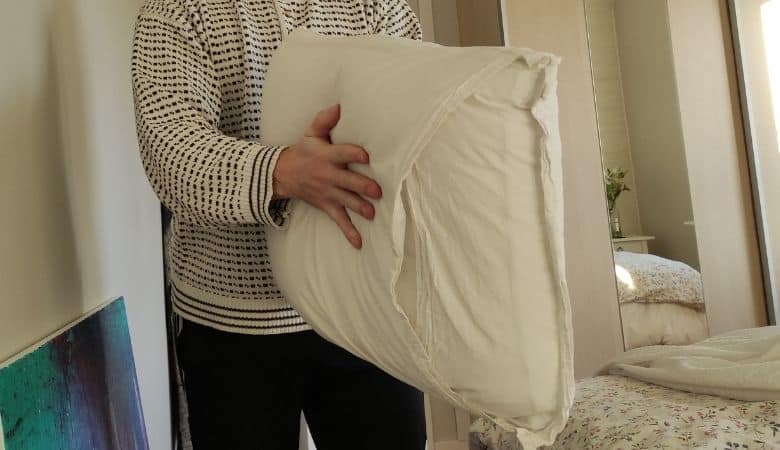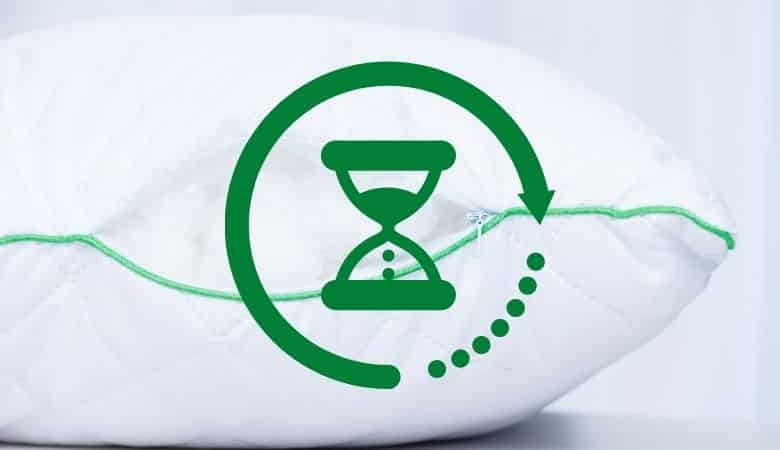This post is part of the complete cotton pillow buyers guide
Cotton is a bit firmer and thicker compared to wool or fiberfill. This makes it the most suitable pillow fill for those who like a lofty and supportive pillow.
Cotton pillows are filled with layers of cotton and then covered with a cotton fabric giving it a soft and durable surface.
Your cotton pillow may be soft and comfortable, but it can get lumpy over time, making your sleep uncomfortable. The good news is that these lumps can be restored to their original state.
For you to restore your lumpy cotton pillow to its original state, you will have to get rid of the dirt and moisture inside first. Below, we are going to share with you why your cotton pillow gets lumpy and how you can restore it to its original state.

Why Do Cotton Pillows Get Lumpy?
Your cotton pillow can get lumpy after some time of use. This happens because the cotton inside might have collected dirt, moisture, and debris. When the dirt, debris, and moisture get together, they cause the cotton filling to clump together.
You may be wondering, how did your pillow get moisture? Or dirt? Or debris?
Well, some people sweat while sleeping, and if you are using a pillow, the sweat will be absorbed into the pillow, creating moisture. The dirt can come from your face and hair oil that is usually smeared on the pillow as you sleep.
Dust mites can also cause lumps in your pillow; this can happen if your pillow gets in contact with dust, and it might cause some spots to go flat. Dust mites may not be harmful to you but dealing with them is quite something.
If you have allergic reactions, then the situation might become unbearable for you. Dust mites normally get the chance to invade your pillow when you shed skin and sweat while you sleep. That is why it is important to keep your pillow clean regularly.
Lumps created from the dirt, moisture, and debris can be pretty stubborn to get rid of. You can try stretching or scrunching your pillow, but the lumps will never go away. However, there are other methods you can try that will help you restore your pillow to its original state.
How Do I “Unlump” My Cotton Pillow?
Rempving the lumps from a cotton pillow is an easy task, provided you know what you are doing. The first thing you need to do is get rid of the dirt, debris, and moisture causing the pillow to lump up. The best way to achieve this is by washing your pillow. You can use a washing machine and a dryer to achieve this.

Step 1
Set your washing machine to a cold or warm regular cycle and use the washing detergent, do not add the fabric conditioner.
If your machine is a top-loading one, then you will need to put two pillows to balance but if you are only washing one pillow, then add in some towels.
If your machine is the front loading type, then you will need to put the pillows in and add a full load of laundry to wash; this will give the pillow support.
Step2
After the washing cycle, then you will need to run the pillows through a second rinse cycle. This will help remove any soap residues.
Step 3
Once the pillows are clean, you need to dry them in the machine, place a tennis ball in a sock and add it to the dryer. This will help beat the lumps in the pillows as they dry.
For the pillow to completely dry, you may need more than one drying cycle. At the end of the drying cycle, the lumps should be gone. However, if they are still there, then you will need to move to the next step.
Step 4
If you can still feel the lumps on your pillow, then go ahead and remove the stitches from one side of the pillow. Get the cotton out and spread it on the table.
Feel where the lumps are and move them aside, fluff with your hands. Once all the lumps are gone, re-stuff the pillow and sew where you opened.
Massage The Lumps

Using your hands to work out those lumps is the most effective way to get rid of them.
First, squeeze the pillow between your hands; you will find out where the lumps are. Then use your fingers to work them by massaging the outer fabric of the pillow gently. Continue with this method until all the lumps in the pillow dissipate. After you are done, you can then fluff the pillow, and you are good to go.
Another way that greatly helps is putting your pillow in the sun once in a while between the washings. This will help with aeration, and the sunlight will help dry any moisture left during machine drying or the moisture absorbed at night during your sleep.
Use The Correct Pillowcase
Apart from cleaning and fluffing your pillow, you can avoid or get rid of the lumps by putting your pillow in the correct pillowcase.
If your cotton pillow is small and you put it in a large pillowcase, it will appear flat and unattractive. On the other hand, a pillowcase that fits perfectly will always make your pillow look attractive and have enough space for the filling to fit.
How do I Keep my Cotton Pillow from Lumping?
Keeping an item well maintained always makes it last longer, and pillows are not an exception. If you maintain your cotton pillow properly, it will be able to serve you longer, and it will also help get the lumps at bay.
Therefore, you need to fluff your pillow every morning when you wake up when making your bed. This will help you get rid of any lump that is forming, making it soft and comfortable.
The best way to fluff your pillow is to push the pillow’s sides from the opposite ends on all four sides. This helps move the cotton filling around, getting rid of any lumps that may be inside.
How Often Should I Replace My Cotton Pillow?

Most people find it easy to change the bedsheets, mattress, and comforter but difficult to change the pillows. Remember, your pillow plays an important role in ensuring your spinal alignment is proper.
Therefore, give it the respect it deserves. If you replace your pillow regularly, you get enjoyable, restful nights and no aches when you wake up.
With all these factors in mind, you should change your cotton pillow every 1-2 years. However, other types of pillows can last longer than this period depending on the quality of the material used in their construction. To know when to change your cotton pillow, consider these signs;
- If you are constantly fluffing your pillow so as to get comfortable, then know it is time to get a new one.
- If you notice the lumps have become frequent even if you try to get rid of them, then know your pillow has outgrown its usefulness.
- If your pillow cover has permanent stains resulting from your body oil or sweat, then your pillow needs replacing.
- When you wake up sneezing sometimes, it is because of the dust mites in your pillow; you need to change it as soon as possible.
- Try folding your pillow in half; if it expands back, it is still in perfect shape, but if it stays folded, then you need to get yourself a new pillow.
- If every time you wake up, you experience tension headaches, know your pillow is not doing its work properly, consider changing it.
- If you realize you have switched your sleeping position from your most common position to one that you feel is comfortable for the moment, your pillow is not doing its work well, and you should consider replacing it.
- If you are always waking up tired, it is because you cannot get enough sleep. It’s either you kept turning and tossing trying to find the best comfortable position to sleep in. therefore, it is time for you to consider changing your pillow.
There are many reasons that can contribute to you changing your pillow, and old age is not the only one. You may change your pillow due to an allergic reaction or if you decide to change your sleeping position.
Remember, side sleepers do not use the same pillows as those sleeping on their backs or stomach. Different sleeping positions need different pillow heights; this helps keep the head, neck, and spine aligned.
On the other hand, if you have allergic reactions, you will need to change your pillow more often than the stipulated lifespan.
Why is it Important to Replace my Cotton Pillow?
Replacing pillows more often is important, although it may seem like a daunting task. Using an old pillow can contribute to countless health issues like sore muscles, skin breakouts, and allergic reactions.
If a pillow is old, it accumulates dust mites, pet dander, fungus, and mold. All these can make some people have a runt nose, irritated eyes, itchy skin, or stuffy nose, and you may end up having an uncomfortable sleep.
If you purposely replace your pillow often, it will help you prevent all these problems related to bad pillows.
Apart from the allergens, your face and hair oils, drool, and sweat may also get into your pillow, sipping through the pillowcase. They, in turn, cause yellow stains, which look unpleasant and can also block your pores. This can trigger rashes or acne break out if your skin is sensitive.
If you wash your pillow and their cases using a mild detergent, you help get rid of the buildup; however, if you replace your cotton pillow, you get to have a fresh start that will be friendlier to your skin.
The most important role of a pillow is to offer support to your head, neck, and shoulders as you sleep. An old or saged pillow can not help you achieve this; instead, you will wake up with sore muscles and feeling unrefreshed.
If you realize that your pillow is not doing its job as effectively as it should, it is time to replace it. Continued fluffing and folding can only get you so far, but the problems will keep occurring.
How do I Get the Most out of my Cotton Pillow?
Every different pillow has a different lifespan which can be shortened significantly with inadequate care. There is a way you can get the most out of your pillow from the moment of purchase.
The moment you get a new pillow, the first thing to do is read the label and find out the proper way to care for your pillow. If the label states that you should machine wash your pillow every six months, make sure you follow to make sure your pillow stays for long.
Once you wash it, make sure to dry the pillow properly, you can machine dry slowly and then transfer it to the sun to get rid of all the moisture.
A dump pillow will encourage the growth of mold and fungus, which in turn can cause an allergic reaction. Changing your pillowcase frequently also helps prolong your pillow’s lifespan. If your pillowcase is dirty, the dirt can sip into the pillow’s filling, causing problems in the end.
Conclusion
Cotton pillows are soft and comfortable to use; they don’t have any smell like most pillows do when they are new. They are also the best recommendation for those who are allergic to down pillows, those with a vegan lifestyle, and those who are environmentally cautious.
They are biodegradable, which makes them more ecologically sound compared to the other types of pillows. The most important thing to do is to take good care of them.
Make sure you wash them according to the material’s specifications. This can help prolong your pillow’s lifespan. Follow the manufacturer’s instructions about cleaning closely and caring for your pillow.
Cotton Pillows: A Complete Buyers Guide – Parts:
1. Why Use a Cotton Pillow? The Benefits & Drawbacks
2. Cotton vs. Microfiber Pillows: Differences, And is One Better?
3. How Long do Cotton Pillows Last? This is The Replacement Time
4. Why Do Cotton Pillows Get Lumpy? How to “Unlump” Your Pillow
5. Do Cotton Pillows Flatten Over Time? How to Fluff a Pillow
6. Best Cotton Pillows of 2022 – Complete Review
7. How to Wash And Dry a Cotton Pillow: Step by Step
